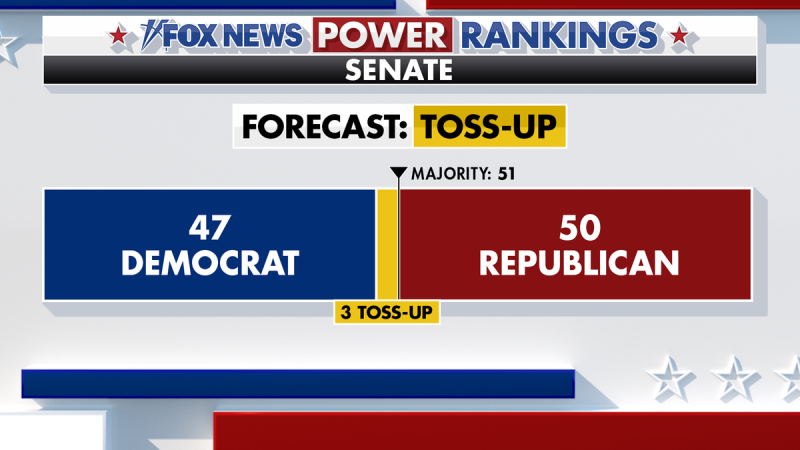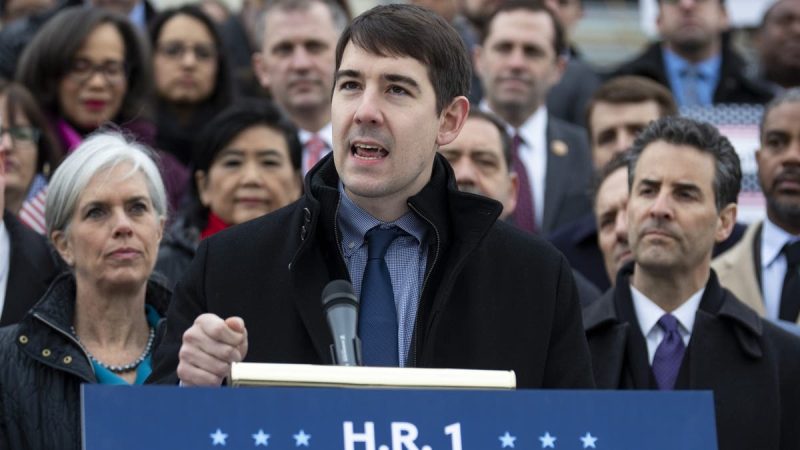
Fox News Power Rankings: Voters’ appetite for ticket-splitting will decide the Senate
Republicans have a favorable map, but Democratic candidates are on top in several battleground states. It is anyone’s game in the first Fox News Power Rankings for the Senate this cycle.
If you know one fact about the 1984 presidential election, it’s that Ronald Reagan won in a landslide. With wins in 49 states and a total of 525 electoral college votes, no candidate has ever pulled off a larger victory.
You might not remember that in the same election, Republicans lost two Senate seats, leaving them with a total of just 53 in the upper chamber.
Outcomes like these used to be normal. Voters have opted for different party winners in more than a hundred races with a presidential and senate election on the same ballot in the postwar era, with the practice reaching its peak in the 1970s and 1980s.
Today, voters are much more loyal to their party. In the last presidential cycle, the electorate only chose different party winners in one out of the 35 states with presidential and senate races (Maine, where Susan Collins held on for a fifth term).
Calculated another way, Democratic and Republican senate candidate vote-shares each differed from the top of the ticket by an average of 2.4 points.
The outcome of the presidential race will therefore heavily influence the result of most of the 34 senate seats up for election this year. In fact, the Power Rankings have the same party winning the presidential and senate races in every state where one party has an edge in both forecasts.
However, the exceptions to this rule will determine who takes control of the upper chamber.
Republicans are chasing wins in two Trump-leaning states that have held on to moderate Democratic incumbents.
Nearby, a handful of Democratic candidates have been outperforming their presidential counterpart, even after the party’s last-minute candidate switch.
The performance of the top of the ticket will be important in those races, but candidate quality, efficient campaigning and a message targeted to local voters will make all the difference.
The Reagan era can feel long forgotten in America. This year, we find out if ticket splitting is a distant memory too.
Republicans have a head start on their road to a Senate majority thanks to a favorable map. The GOP has a clear advantage in all the seats they will defend this year, whereas Democrats must defend eight seats that are hotly contested.
Democrats will also kick off the night with a very likely loss in West Virginia.
The seat is currently held by Sen. Joe Manchin, who decided not to run for re-election earlier this year. The senator’s enduring relationship with West Virginians helped him eke out a 3-point win in 2018, but with Trump’s nearly 39-point win in the last presidential race, this is deep red territory. Democrats needed Manchin on the ballot to put up a good fight.
That victory alone would give Republicans 50 senate seats, or one short of a majority. (If Trump wins the presidential race, the GOP would rule the senate even without a majority because the Vice President breaks ties.)
To guarantee control, Republicans are looking for victories in Montana and Ohio.
Some of the dynamics in these races are similar to West Virginia. In 2020, Trump won Montana by 16 points and Ohio by 8 points. Two years earlier, Democratic incumbent Sens. Jon Tester and Sherrod Brown won the same states by nearly four and seven points, respectively.
Republicans are optimistic that victories in both races are within reach. Tester and Brown have mostly voted in line with the Biden administration’s priorities, and the GOP has fielded capable candidates in both states, including retired Navy SEAL Tim Sheehy in Montana and businessman Bernie Moreno in Ohio.
At the same time, the Democrats’ sitting senators have bucked their party on the items that matter most to their voters. Tester is a key proponent of the Keystone XL pipeline, for example, and Brown has pushed his party to support more tariffs on Chinese imports.
Montana and Ohio are toss-ups.
Despite a challenging Senate map, Democrats have been buoyed by strong polling in most of the seats they are defending.
That includes Michigan, Pennsylvania and Wisconsin, three famously swingy rust belt states at the heart of the presidential race. Recent Fox News surveys for each of these three races show more than 50% of voters supporting the Democratic candidate.
In Michigan, congresswoman and former CIA analyst Elissa Slotkin (D) is ahead of former congressman and former FBI agent Mike Rogers (R) by a 51-46% margin, or five points. In Pennsylvania, third term Sen. Bob Casey (D) leads businessman and Bush administration official Dave McCormick (R) by a 55-42% margin, or 13 points. In Wisconsin, second-term senator and presumptive nominee Tammy Baldwin (D) leads banker and likely nominee Eric Hovde (R) by a 54-43% margin, or 11 points (Wisconsin’s primary takes place tomorrow).Slotkin, Casey and Baldwin are all experienced politicians. They are running well-funded campaigns and hoping that focusing on local issues like infrastructure, child safety and health care funding will get them over the line.
These races are far from settled. Republicans will look to build more name awareness for their candidates as their races heat up, and hope to remind voters that their opponents have been supportive of the Biden administration’s economic and immigration policies.
However, these polling leads give the Democrats an advantage today. Michigan, Pennsylvania and Wisconsin’s senate races are rated Lean D.
In the southwest, Republican and former local news anchor Kari Lake is running her second statewide race in Arizona after an unsuccessful bid for governor in 2022.
Lake ran very close in that election, but her 17,117 vote loss was nearly double that of former President Trump’s in 2020, and in the 2022 Fox News Voter Analysis, she ran 28 points behind her Democratic opponent with independents.
This time, she faces Rep. Ruben Gallego (D-AZ-3), an Iraq War veteran, progressive and critic of retiring independent Sen. Kyrsten Sinema. With the border a top issue, Lake and allies have hit Gallego on his support for sanctuary cities, among other liberal immigration policies.
Gallego has an edge on Lake in recent polls and more than triple her cash on hand. A strong Trump showing in Arizona may be enough to give Lake a victory, but this race begins at Lean D.
The most competitive swing state race is in Nevada, where Democratic incumbent Jacky Rosen is seeking a second term. She is up against Republican and Afghanistan War veteran Sam Brown.
Rosen is running the same kind of small target campaign as her fellow incumbents in the rust belt, while Brown is leaning on his military experience and a Trump endorsement.
Nevada is one of the closest states on the board in the presidential race, and neither candidate has a consistent polling lead. Rosen ended June with triple Brown’s cash on hand, but that is not enough to give an edge to either party yet. This race is a toss-up.
In the races discussed in this forecast so far, Republicans are chasing wins in either very competitive or right-leaning presidential states.
In Maryland, the GOP is looking for an upset in deep blue territory.
The Old Line State voted for President Biden over Trump by a whopping 33 points in 2020, and its high proportion of Black voters and college-educated voters gives Democrats an advantage right out of the gate.
If anyone can challenge this script, it is former Governor Larry Hogan.
Hogan governed as a moderate and a Trump skeptic in his eight years in office. That is the recipe the GOP needs for a shot here, and so far, voters say they like Hogan. He started the race with a 64% favorable rating among Maryland registered voters.
The challenge will be convincing Democratic voters who liked Hogan for governor that they should back him in the Senate too. Pro-Roe and anti-Trump positioning will help him with moderates, just as Trump’s surprise endorsement will keep rancor among ‘MAGA’ voters at bay.
Democrats still have an edge. Not only is the electoral math in their favor, but candidate Angela Alsobrooks has raised more money and is leaning effectively on her experience as a county executive and prosecutor.
Endorsements from Vice President Harris and the Washington Post will be helpful. Maryland starts at Lean D.
Power Rankings mania continues tomorrow with the first U.S. House forecast. Check back here and watch America’s Newsroom to see predictions for all 435 districts.
On Wednesday, come back again for a first look at the 11 governor’s races up for grabs in 2024. An all-new Power Rankings Issues Tracker caps off the week as Democracy 24 special coverage for the Democratic National Convention begins.



